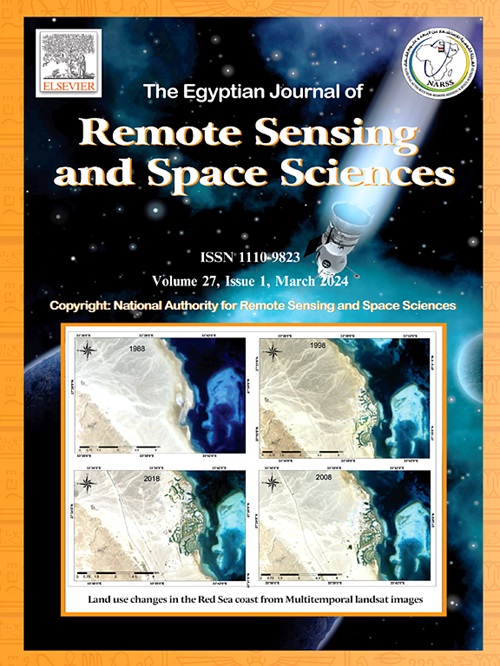Identifying water-lubricated faults in the vicinity of a dam
IF 3.7
3区 地球科学
Q2 ENVIRONMENTAL SCIENCES
Egyptian Journal of Remote Sensing and Space Sciences
Pub Date : 2025-01-24
DOI:10.1016/j.ejrs.2025.01.003
引用次数: 0
Abstract
The development of remote sensing, with its many applications, combined with field data collected by geologists, geophysicists and geotechnical scientists, is now contributing to sustainable development in the mining, infrastructure and civil protection sectors. This study integrates remote sensing and the audiomagnetotelluric (AMT) method to identify faults lubricated or potentially lubricated by water in the vicinity of a dam. The data set includes SRTM_DEM images and AMT data from seven stations collected in the study area. The results from remote sensing show 284 lineaments with a main NE-SW direction, including 17 corresponding to existing faults in the area. The lineament density map shows that stations A1, A3 and A7 are located in the most fractured zones. The Bahr dimensional analysis shows that, at the same frequencies, Swift skew values of less than 0.1 and two-dimensionality parameter values of greater than 0.1 are observed at stations A3, A5 and A7, suggesting the presence of 2D structures correlating with the faults at these stations, oriented NE-SW, NE-SW and NNE-SSW respectively. In addition, the 2D and 3D resistivity models make it possible to distinguish at what depth the faults highlighted can be lubricated by water in the study area containing a total of 39 faults, 17 of which are normal and may be partially or fully lubricated depending on whether they interact with the hydrographic or drainage network. These identified lubricated faults need further study, as they could induce weak earthquakes.
求助全文
约1分钟内获得全文
求助全文
来源期刊
CiteScore
8.10
自引率
0.00%
发文量
85
审稿时长
48 weeks
期刊介绍:
The Egyptian Journal of Remote Sensing and Space Sciences (EJRS) encompasses a comprehensive range of topics within Remote Sensing, Geographic Information Systems (GIS), planetary geology, and space technology development, including theories, applications, and modeling. EJRS aims to disseminate high-quality, peer-reviewed research focusing on the advancement of remote sensing and GIS technologies and their practical applications for effective planning, sustainable development, and environmental resource conservation. The journal particularly welcomes innovative papers with broad scientific appeal.

 求助内容:
求助内容: 应助结果提醒方式:
应助结果提醒方式:


